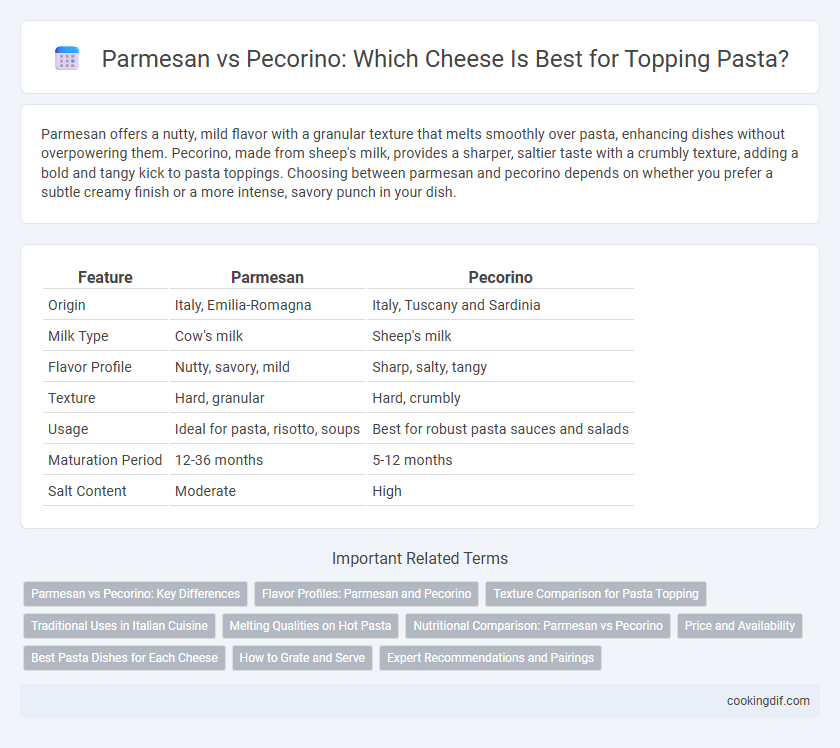Parmesan offers a nutty, mild flavor with a granular texture that melts smoothly over pasta, enhancing dishes without overpowering them. Pecorino, made from sheep's milk, provides a sharper, saltier taste with a crumbly texture, adding a bold and tangy kick to pasta toppings. Choosing between parmesan and pecorino depends on whether you prefer a subtle creamy finish or a more intense, savory punch in your dish.
Table of Comparison
| Feature | Parmesan | Pecorino |
|---|---|---|
| Origin | Italy, Emilia-Romagna | Italy, Tuscany and Sardinia |
| Milk Type | Cow's milk | Sheep's milk |
| Flavor Profile | Nutty, savory, mild | Sharp, salty, tangy |
| Texture | Hard, granular | Hard, crumbly |
| Usage | Ideal for pasta, risotto, soups | Best for robust pasta sauces and salads |
| Maturation Period | 12-36 months | 5-12 months |
| Salt Content | Moderate | High |
Parmesan vs Pecorino: Key Differences
Parmesan and Pecorino are two popular cheese toppings for pasta, each with distinct characteristics that influence flavor and texture. Parmesan, made from cow's milk, offers a nutty, savory taste with a granular texture, ideal for adding depth without overwhelming the dish. Pecorino, derived from sheep's milk, features a sharper, saltier flavor and a firmer, crumbly texture, providing a bold contrast that enhances rustic pasta recipes.
Flavor Profiles: Parmesan and Pecorino
Parmesan offers a nutty, savory flavor with subtle fruity undertones, delivering a slightly granular texture that melts smoothly over pasta. Pecorino presents a sharper, saltier taste derived from sheep's milk, providing a bold, tangy punch with a crumbly consistency that enhances richer pasta dishes. Both cheeses elevate pasta, but Parmesan complements milder sauces while Pecorino intensifies robust, spicy flavors.
Texture Comparison for Pasta Topping
Parmesan cheese offers a granular, slightly crystalline texture that melts evenly over hot pasta, providing a subtle crunch and enhancing the dish's mouthfeel. Pecorino, in contrast, features a firmer, more crumbly texture with a sharper bite that adds a robust, tangy dimension when sprinkled as a topping. The choice between parmesan and pecorino impacts the pasta's final texture, with parmesan delivering a smoother, creamier finish while pecorino contributes a coarser, more textured experience.
Traditional Uses in Italian Cuisine
Parmesan, aged at least 12 months and known for its nutty, salty flavor, is traditionally used in Northern Italian pasta dishes like risotto and tagliatelle. Pecorino Romano, a sheep's milk cheese with a sharper, saltier taste, is favored in Central and Southern Italy, especially for classic recipes like Cacio e Pepe and Carbonara. These regional cheese preferences highlight the distinct culinary traditions and flavor profiles that define Italian pasta cuisine.
Melting Qualities on Hot Pasta
Parmesan cheese offers a subtle melt with a granular texture that enhances pasta without becoming overly creamy, preserving its distinct nutty flavor. Pecorino Romano melts more evenly and swiftly on hot pasta, providing a sharper, saltier taste with a smoother, slightly creamier finish. Both cheeses improve pasta dishes, but Parmesan suits more delicate melts while Pecorino excels in richer, robust sauces.
Nutritional Comparison: Parmesan vs Pecorino
Parmesan cheese contains approximately 431 calories and 38 grams of protein per 100 grams, offering a rich source of calcium and phosphorus essential for bone health. Pecorino, derived from sheep's milk, has a higher fat content with about 387 calories and 28 grams of protein per 100 grams, alongside elevated sodium levels, which can impact cardiovascular health. Both cheeses provide significant amounts of vitamins A and B12, but Parmesan's lower fat and sodium content make it a leaner choice for cheese toppings on pasta dishes.
Price and Availability
Parmesan cheese, particularly Parmigiano-Reggiano, is typically more expensive and widely available in most supermarkets and specialty stores due to its global demand and aged quality standards. Pecorino, especially Pecorino Romano, tends to be more affordable and is often found in Italian markets or sections, but availability may be limited outside of regions with strong Italian culinary influence. Price differences reflect production methods and aging time, with Parmesan being aged longer, which contributes to its higher cost and broader market presence.
Best Pasta Dishes for Each Cheese
Parmesan cheese, with its nutty and savory flavor, pairs exceptionally well with classic Italian pasta dishes like Fettuccine Alfredo and Spaghetti Carbonara, enhancing their creamy textures and rich sauces. Pecorino Romano, saltier and sharper, is ideal for robust dishes such as Cacio e Pepe and Amatriciana, where its bold taste complements the pepper and tomato-based sauces perfectly. Choosing Parmesan or Pecorino depends on the pasta's flavor profile, with Parmesan suited for milder, creamier recipes and Pecorino best for dishes requiring a strong, tangy cheese topping.
How to Grate and Serve
Parmesan offers a hard texture that grates finely and melts smoothly over pasta, enhancing dishes with a nutty, savory flavor ideal for light toppings. Pecorino, made from sheep's milk, has a saltier and sharper taste, requiring coarser grating to balance its intensity and provide a bold finish. Serve Parmesan as a subtle, uniform layer while Pecorino works best sprinkled sparingly to maintain its strong, tangy character that complements rich pasta sauces.
Expert Recommendations and Pairings
Experts recommend Parmesan for pasta dishes requiring a nutty, slightly sweet flavor and a granular texture, ideal for classic Italian recipes like spaghetti carbonara or fettuccine Alfredo. Pecorino Romano is preferred for its sharper, saltier profile and crumbly texture, complementing robust sauces such as amatriciana or cacio e pepe. Chefs often pair Parmesan with lighter pasta and vegetable-based sauces, while Pecorino enhances meat and tomato-based dishes, highlighting authentic regional Italian tastes.
parmesan vs pecorino for cheese topping Infographic

 cookingdif.com
cookingdif.com